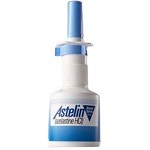Vasomotor Rhinitis: A Comprehensive Overview


Vasomotor rhinitis is a chronic nasal condition characterized by persistent congestion, runny nose, and postnasal drip, which are not caused by allergy or infection. Unlike allergic rhinitis, where immune responses to allergens drive symptoms, vasomotor rhinitis stems from abnormal regulation of blood flow within the nasal tissues. The “vaso” element refers to blood vessels, and “motor” refers to their control — events like sudden changes in temperature, environmental irritants, strong odors, or even emotional stress can trigger exaggerated vascular reactions in the nasal tissues, resulting in persistent symptoms.
The prevalence of vasomotor rhinitis remains underrecognized. It often surfaces after the more familiar causes of nasal symptoms have been excluded. Despite lacking the hallmark signs of infection or allergy, it can profoundly impact quality of life due to its chronic, fluctuating symptoms that can be as debilitating as those of its allergic counterpart.
What Really Causes Rhinitis?
To understand vasomotor rhinitis clearly, it’s worth exploring the broader category of rhinitis. Inflammation of the nasal mucosa — rhinitis — can be caused by many factors. Allergic rhinitis involves immune-mediated responses to pollen, dust mites, or animal dander, while infectious rhinitis is caused by viruses or bacteria. In each case, the immune and inflammatory responses trigger nasal symptoms.
Vasomotor rhinitis lies outside this spectrum. The underlying mechanism involves imbalances between the sympathetic and parasympathetic nervous systems, which regulate the tone of blood vessels in the nasal lining. The sympathetic system typically acts to constrict blood vessels, reducing nasal congestion, while the parasympathetic system promotes vessel dilation and mucus production. In vasomotor rhinitis, an overactive or improperly modulated parasympathetic response (potentially affecting the trigeminal nerve as well) can trigger persistent congestion, drainage, and sneezing in response to non-allergic triggers.
Because the cause is rooted in dysregulation, there is no bacterial or allergic target for treatment. This differs from other forms of rhinitis, where antihistamines, decongestants, or antibiotics may play a role.
Gustatory versus Vasomotor Rhinitis: What’s the Difference?
At first glance, gustatory and vasomotor rhinitis may seem similar, as both can present with nasal symptoms absent allergy or infection. However, their triggers and mechanisms differ significantly. In gustatory rhinitis, the trigger is a specific physiological process: when a person eats, especially spicy or hot foods, stimulation of the parasympathetic system in the mouth causes reflex nasal secretions. This results in immediate watery rhinorrhea — a runny nose often limited to the time around mealtimes.
Vasomotor rhinitis is more generalized. It is not confined to eating and can be triggered by a host of physical or environmental changes — temperature shifts, strong smells, humidity, perfumes, pollution, or emotional stress. Though gustatory rhinitis could be seen as a subtype of vasomotor rhinitis, it is distinguished by a very specific trigger (eating) and pattern (acute onset around meals), whereas vasomotor rhinitis involves broader dysregulation and chronically shifting patterns of symptoms.
Is Vasomotor Rhinitis a Neurological Disorder?
Although vasomotor rhinitis is not classified as a neurological disorder in a strict sense, it does involve neurological mechanisms. The nasal tissues are richly innervated by autonomic nerve fibers that regulate blood flow and mucus secretion. In vasomotor rhinitis, these nerves are overly reactive or improperly modulated, leading to exaggerated responses to stimuli that typically would not cause issues.
Imaging and physiological studies suggest that overactivity in parasympathetic pathways — or insufficient sympathetic counterbalance — plays a pivotal role. There is also an implication of central nervous system pathways, such as in the brainstem, which govern autonomic outflow. In that sense, vasomotor rhinitis sits at the intersection of ENT and neuro-autonomic medicine: it is a disorder of autonomic regulation localized in nasal tissues, but not a neurological disorder in the sense of epilepsy, neuropathy, or motor neuron disease.
Thus, while vasomotor rhinitis has a neurophysiological foundation, it is typically classified under ENT and allergy. Its neurological aspects are important, however, especially when considering treatment approaches that may involve neural modulation or autoinhibition rather than simple immunological or anti-inflammatory therapies.
Why Do I Sneeze Twenty Times in a Row?
Sneezing fits — also known as paroxysmal sneezing — commonly occur in vasomotor rhinitis. This happens when the nasal irritant reaches a threshold that triggers the sneeze reflex via the trigeminal nerve (which mediates facial sensation including nasal mucosa). In sensitive individuals, certain stimuli — like sudden exposure to cold air, strong odors, or irritants — can cause prolonged sequences of sneezes as the reflex loop is repeatedly triggered before the nasal tissues settle.
These sneezing bouts are more than a nuisance; they manifest the hyper-responsiveness of the nasal reflexes. The intensity and frequency of sneezing can disturb sleep, social interactions, and daily functioning. Although distressing, such sneezing does not necessarily indicate infection — it reflects sensitivity and refractoriness of neural reflex arcs within the nose.
The Role of Astelin Spray in Treating Vasomotor Rhinitis
Astelin (azelastine hydrochloride) nasal spray represents an effective targeted therapy for vasomotor rhinitis. Azelastine is primarily an antihistamine noted for its potent antiallergic and moderate anticholinergic effects. While its antihistaminic action helps reduce sneezing and rhinorrhea related to histamine, azelastine’s neural stabilizing and antimuscarinic actions dampen the parasympathetic overactivity seen in vasomotor rhinitis.
Clinical research has demonstrated that azelastine reduces nasal congestion, sneezing, and rhinorrhea in non-allergic rhinitis patients. Improvement is often noted within hours of administration, providing fast symptomatic relief. Moreover, because Astelin does not rely on corticosteroids, it avoids many of the concerns associated with long-term steroid use, such as mucosal irritation or systemic side effects.
The standard adult regimen typically involves one to two sprays in each nostril twice daily, though specific dosing may vary. Patients often report better control of symptoms like postnasal drip, nasal irritation, and sneezing than with other topical antihistamines. Side effects are generally mild, including a bitter taste, slight nasal irritation, or drowsiness in a minority of patients. Overall, Astelin represents a well-tolerated, non-sedating, non-steroidal option that addresses the neural component of vasomotor rhinitis.
Integrative Treatments: Beyond Medication
While Astelin provides direct benefit by modulating nasal autonomic activity, an integrative strategy often yields the best results. Behavioral modifications — such as nasal saline rinses — can soothe inflamed tissues and support mucociliary clearance. Avoiding known triggers like strong fragrances, abrupt temperature changes, or environmental irritants helps to reduce flare-ups.
In more complex or severe cases, additional pharmacological measures may be used. Low-dose intranasal corticosteroids can reduce chronic nasal inflammation, and ipratropium bromide spray can inhibit excessive cholinergic-mediated nasal secretions. Neuromodulation techniques such as capsaicin desensitization — where topical capsaicin is used to attenuate nerve overreactivity — may be considered experimental but show promise for refractory cases.
Ultimately, the goal is to stabilize nasal neural reactivity and reduce symptomatic burden. Patient education about the condition’s triggers and natural history empowers individuals to take proactive steps in managing their own symptoms.
Prognosis and Long-Term Outlook
Vasomotor rhinitis is typically a chronic condition, with symptoms that may wax and wane over time. However, while a complete cure remains elusive, many patients achieve significant relief with long-term management. Astelin spray, lifestyle adjustments, and targeted therapies often combine to reduce symptom severity, frequency, and impact on daily life.
In most cases, vasomotor rhinitis will not cause serious complications. Rarely, chronic nasal congestion may lead to sinus pressure or contribute to secondary lower airway irritability in susceptible individuals. Seeking tailored treatment early can prevent progression and maintain better nasal health.
With evolving research into neurogenic inflammation, nasal reflex physiology, and local immune regulation, new therapies may emerge — potentially restoring autonomic balance within nasal tissues. For now, the combination of neural-modulating sprays such as Astelin, environmental control, and thoughtful clinical follow-up forms the cornerstone of effective management.
Conclusion
Vasomotor rhinitis is a distinct form of chronic rhinitis arising from autonomic dysregulation rather than allergy or infection. Unlike gustatory rhinitis, which is narrowly focused on eating-related triggers, vasomotor rhinitis responds to a variety of non-specific stimuli. Though rooted in nasal neurophysiology, it is not a classic neurological disease.
Persistent sneezing fits — like sneezing 20 times in a row — stem from hypersensitive nasal reflex pathways. Astelin nasal spray offers targeted relief by stabilizing neural responses and reducing symptoms without the drawbacks of steroids. Integrative strategies including trigger avoidance, saline rinses, and advanced therapies optimize long-term comfort and control, helping patients navigate life with minimal nasal disruption.
Medically Reviewed by Dr. Rabeea Aboufakher, MD
(Updated at Jun 12 / 2025)

